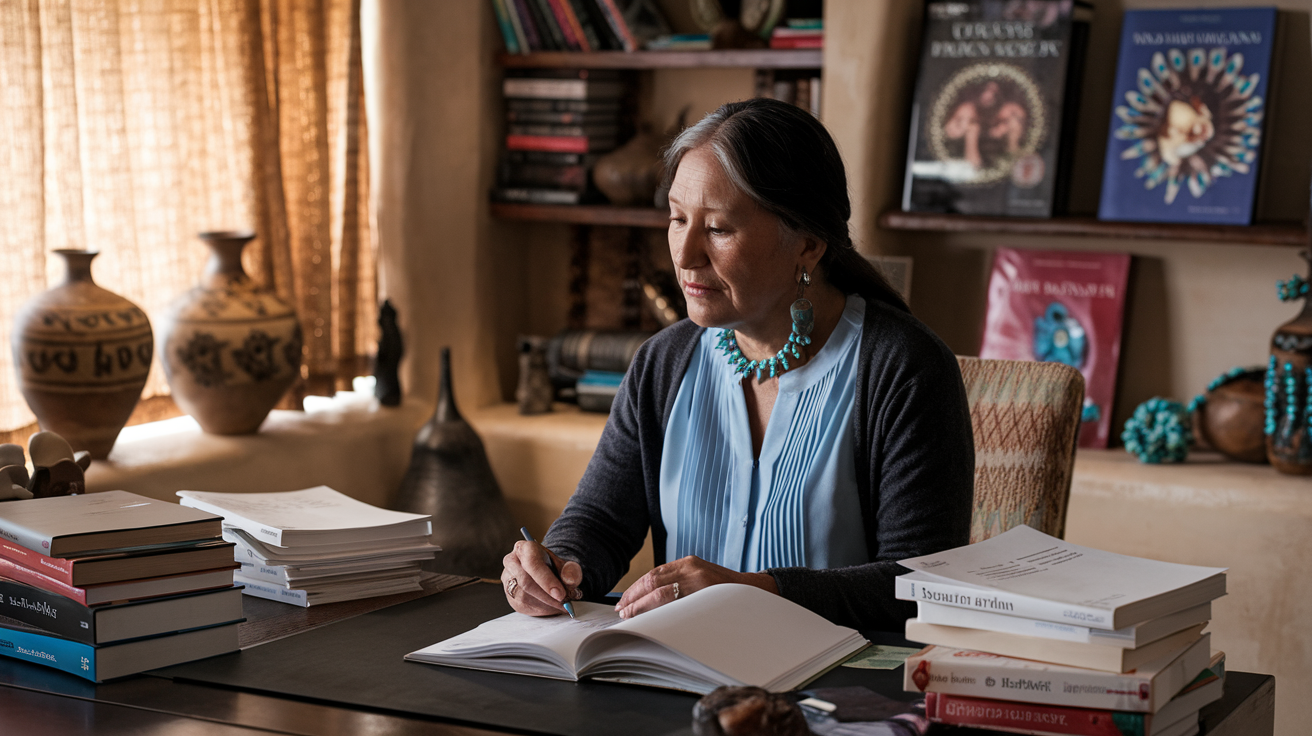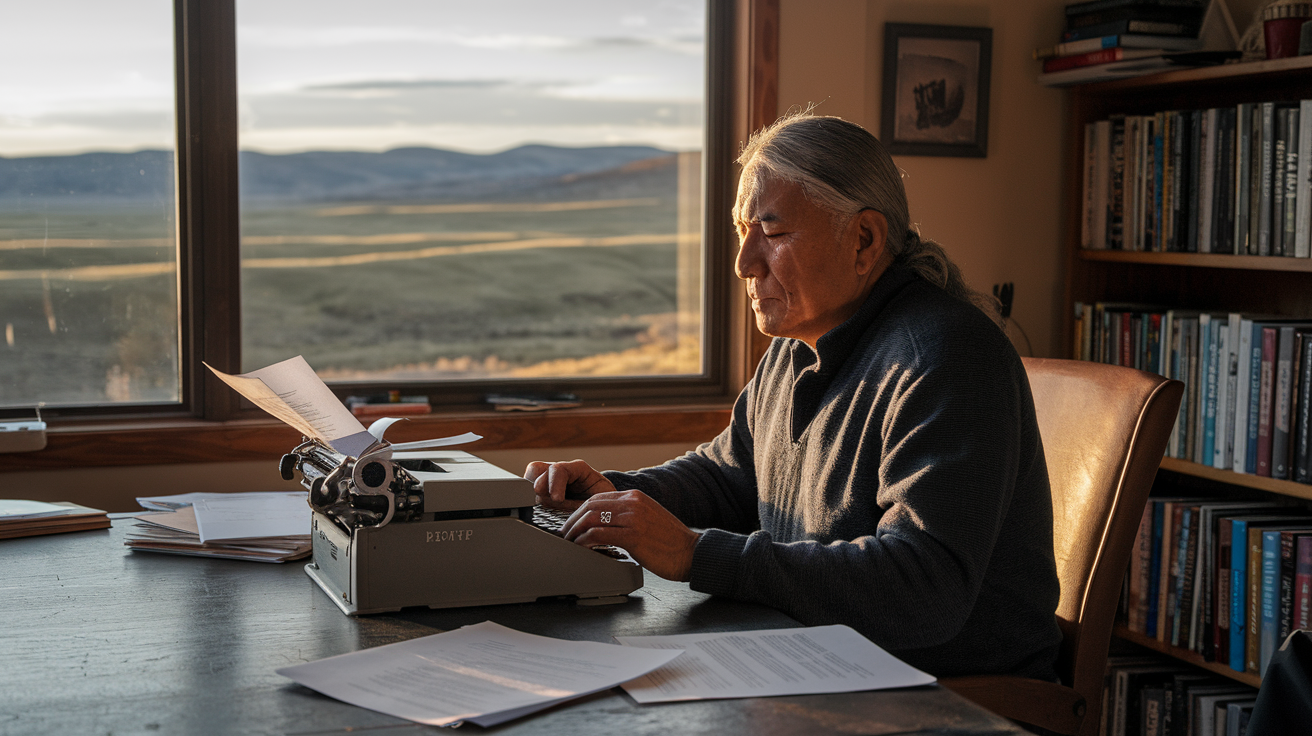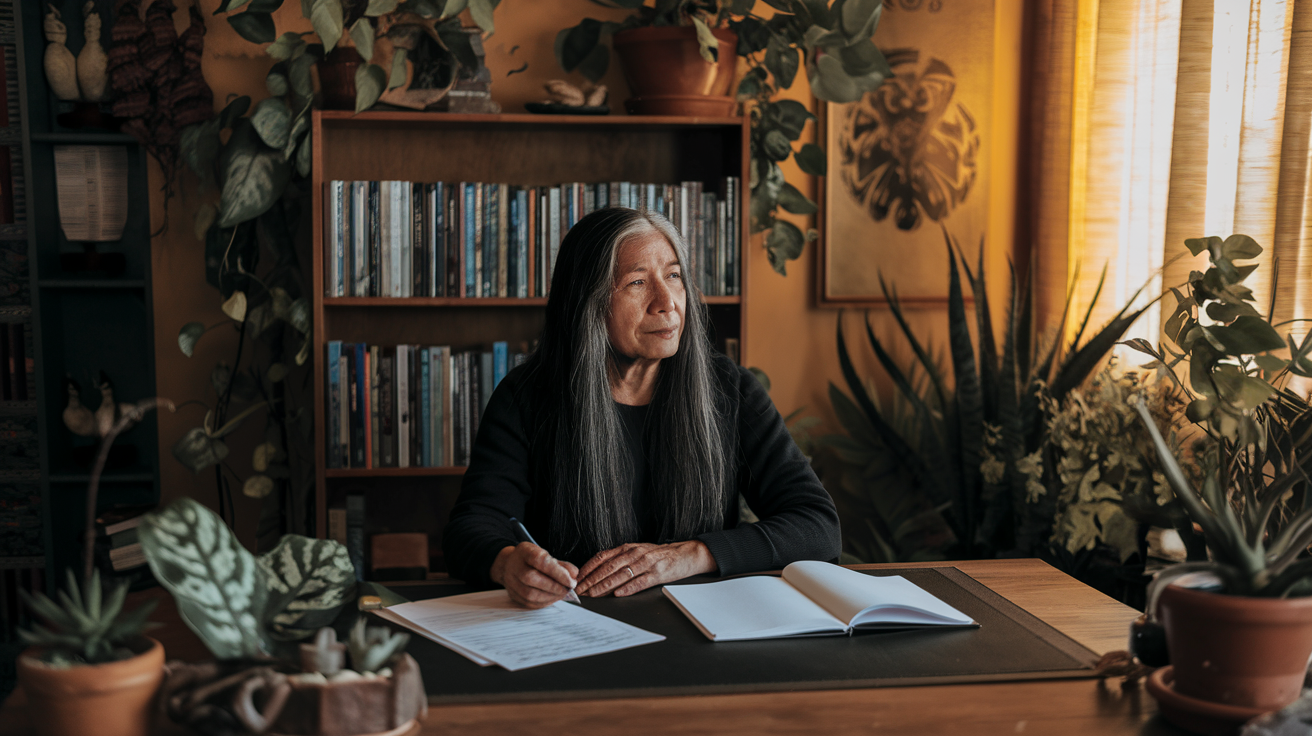5 Hidden Native American Authors You Need to Discover
Ever notice how the most incredible voices in literature sometimes get buried under mainstream bestsellers? That’s the story of Native American authors, whose profound narratives often slip through the cracks of our reading lists.
But here’s the thing – these overlooked indigenous writers aren’t just filling diversity quotas. They’re reshaping how we understand American identity, history, and storytelling itself.
I’ve spent years exploring Native American literature beyond the usual suspects, and the hidden gems I’ve found deserve serious spotlight. These five authors bring perspectives you won’t find anywhere else – stories that challenge, inspire, and sometimes uncomfortably confront our shared history.
Ready to discover voices that might just change how you see America? The authors I’m about to introduce aren’t just good – they’re revelatory.
The Literary Significance of Native American Voices

Historical underrepresentation in publishing
Native American voices have been notoriously absent from mainstream publishing for centuries. This isn’t accidental. The American literary landscape has systematically excluded Indigenous perspectives through both overt discrimination and subtle institutional barriers.
Think about the classic American literature you were assigned in school. How many Native American authors made the cut? Probably none. While white authors like James Fenimore Cooper and Laura Ingalls Wilder freely wrote about (and often misrepresented) Indigenous peoples, actual Native voices were pushed to the margins.
Until the 1970s, major publishing houses rarely published Native American authors. When they did, these writers often faced impossible expectations: be “authentic” but accessible to white audiences, be political but not too angry, be cultural but not too “exotic.” Native writers were caught in a double bind – either conform to stereotypical expectations or be deemed unpublishable.
The numbers tell a stark story. A 2019 study by the Cooperative Children’s Book Center found that of the approximately 4,000 children’s books published that year, only 1% featured Native or Indigenous characters, and fewer still were actually written by Native authors. Adult publishing statistics aren’t much better.
The barriers extended beyond simple rejection letters. Native authors have historically lacked access to:
- Literary agents familiar with Indigenous perspectives
- Editors who understand tribal contexts
- Marketing teams who know how to position their work
- Review outlets willing to engage with their themes
But underrepresentation isn’t just about numbers. It’s about who controls the narrative. For too long, stories about Native Americans were told by outsiders, reinforcing harmful stereotypes and erasing the complexity of Indigenous experiences.
Cultural preservation through storytelling
In Native American traditions, stories aren’t just entertainment – they’re survival. Long before European contact, Indigenous peoples used oral storytelling to preserve history, transmit cultural knowledge, and maintain spiritual practices across generations.
When you hear a Native author write about “stories,” they’re often talking about something much deeper than plot and character. They’re referring to a sacred tradition that connects past, present, and future.
This tradition of storytelling serves multiple crucial functions:
- Recording tribal histories without written language
- Teaching moral and ethical values to younger generations
- Explaining natural phenomena and human origins
- Preserving language even as speakers dwindled
- Maintaining spiritual practices despite religious persecution
For tribes that faced cultural genocide through boarding schools, land theft, and forced relocation, stories became lifelines to identity. When children were forbidden from speaking their native languages, when ceremonies were banned, when communities were scattered—stories remained.
Native American literature today continues this tradition of cultural preservation. When Leslie Marmon Silko weaves Laguna Pueblo creation stories into her novel “Ceremony,” she’s not just creating art—she’s ensuring these stories survive. When Louise Erdrich incorporates Ojibwe language and traditions into her fiction, she’s creating a written record of cultural knowledge that might otherwise be lost.
What makes this preservation so powerful is how it adapts. Today’s Native writers don’t simply transcribe oral tales; they transform them into new forms that speak to contemporary realities while honoring traditional structures. They’re not museum pieces—they’re living, evolving traditions finding new expression through the written word.
Unique perspectives on American history and identity
Native American literature flips the American narrative on its head. While mainstream history often frames the United States as a story of progress and expansion, Indigenous writers reveal the devastation and resistance that narrative obscures.
This alternative view isn’t just politically important—it’s artistically revolutionary. Native writers occupy a unique position: they witness American culture both from within and without. They’re insiders with outsider perspectives, citizens of both tribal nations and the United States.
This dual consciousness produces literature that:
- Challenges the mythology of American “discovery” and “frontier”
- Reimagines historical events from Indigenous perspectives
- Questions linear Western concepts of time
- Explores identity formation under colonization
- Reconnects land and story in ways Western literature often fails to
Take James Welch’s historical novel “Fools Crow.” Rather than portraying the “winning of the West” as inevitable progress, Welch shows readers the Blackfeet world before, during, and after white encroachment—a complex civilization facing devastating change, not an empty wilderness awaiting “civilization.”
Or consider David Treuer’s non-fiction work “The Heartbeat of Wounded Knee,” which directly challenges the notion that Native American history ended with the 1890 massacre. Instead, Treuer chronicles how Native peoples adapted, survived, and maintained cultural identity despite overwhelming pressures.
What’s remarkable about these perspectives is how they complicate simplistic understandings of American identity. Native authors don’t just add “diversity” to American literature—they fundamentally question what “American” means. They remind readers that the United States exists on contested ground, both literally and figuratively.
These writers also challenge literary conventions around time, space, and narrative. When Linda Hogan writes about the interconnectedness of humans and nature, she’s not engaging in metaphor but expressing a worldview fundamental to many Indigenous cultures. When N. Scott Momaday blends memoir, myth, and history, he’s not being experimental for its own sake but reflecting traditional storytelling methods.
Rising recognition in contemporary literature
Something’s changing in American literature, and it’s about time. After centuries of marginalization, Native American writers are finally receiving mainstream recognition and critical acclaim that’s long overdue.
The evidence is everywhere:
- Louise Erdrich won the 2021 Pulitzer Prize for “The Night Watchman”
- Tommy Orange’s “There There” became a national bestseller and critical sensation
- Natalie Diaz received the 2021 Pulitzer Prize in Poetry
- Billy-Ray Belcourt won the Griffin Poetry Prize at just 23 years old
- Joy Harjo served three terms as U.S. Poet Laureate
This isn’t just a few token successes. We’re witnessing what some critics call a “Native American Renaissance 2.0″—a flowering of Indigenous literature across genres, styles, and tribal affiliations.
What’s driving this renaissance? Several factors have converged:
First, a new generation of Native writers has emerged, many educated in MFA programs but deeply connected to their cultural traditions. They’re technically sophisticated while remaining rooted in Indigenous perspectives.
Second, the publishing industry—prompted by broader calls for diversity—has begun addressing its historical biases. New imprints focused on Indigenous voices have launched, and established publishers have actively sought Native authors.
Third, readers themselves have changed. There’s growing recognition that Native perspectives offer essential insights into American history and contemporary issues like environmental justice and cultural identity.
Technology has played a role too. Social media allows Native authors to build audiences directly, bypassing traditional gatekeepers. Online communities connect Indigenous writers with readers and with each other, creating networks of support and collaboration.
What makes this moment particularly exciting is the sheer diversity of Native voices being published. Today’s Indigenous literature includes speculative fiction, memoir, mystery, poetry, young adult novels, graphic novels, and experimental forms that defy categorization. It’s not a monolith but a chorus of distinct voices representing different tribes, urban and reservation experiences, mixed-heritage perspectives, and political viewpoints.
The increased recognition hasn’t come without complications. Some Native authors express concern about publishers seeking “trauma porn” or reinforcing stereotypes of Indigenous suffering. Others worry about the commodification of Native identity in an industry still driven by market demands. The most thoughtful critics note that acclaim for individual Native authors doesn’t necessarily translate to systemic change in whose stories get told.
Despite these valid concerns, the growing presence of Native American voices in contemporary literature represents a profound shift. These writers aren’t just adding diversity to American letters—they’re transforming what American literature can be.
Leslie Marmon Silko: Master of Ceremony

Background and Tribal Influences
Born in 1948 to a mixed Laguna Pueblo, Mexican, and white ancestry, Leslie Marmon Silko grew up on the Laguna Pueblo reservation in New Mexico. But don’t think for a second that her mixed heritage diluted her connection to her Indigenous roots.
The dusty landscapes of New Mexico weren’t just her childhood backdrop—they became the living, breathing foundation of her literary voice. Silko absorbed the oral traditions of the Laguna people directly from her grandmother and great-grandmother, who passed down stories that had survived generations.
What makes Silko unique is how deeply the Pueblo worldview saturates her writing. Unlike authors who merely reference their heritage, Silko’s entire narrative approach is shaped by the circular, interconnected storytelling patterns of Laguna oral tradition. Her understanding of time isn’t linear—it’s cyclical, with past, present, and future existing simultaneously.
The Laguna Pueblo believe in a world where humans, animals, and landscapes share spiritual connections. This isn’t some mystical concept for Silko—it’s reality. Her characters don’t just walk through landscapes; they communicate with them.
During her formative years, Silko straddled two worlds. She attended Bureau of Indian Affairs schools, where Western education often clashed with traditional knowledge. This cultural tension became another thread woven throughout her work—not as political commentary, but as lived experience.
“Ceremony” and Its Lasting Impact
When “Ceremony” hit bookshelves in 1977, nobody was ready for it. Not readers. Not critics. Not the literary establishment.
This wasn’t just another novel—it was a literary earthquake that permanently altered the landscape of American literature. “Ceremony” follows Tayo, a mixed-race WWII veteran battling PTSD, alcoholism, and cultural displacement as he returns to the Laguna Pueblo reservation.
The genius of “Ceremony” isn’t just its unflinching portrayal of reservation life or its exploration of trauma. It’s how Silko demolishes Western literary conventions. The novel weaves together prose, poetry, traditional Laguna stories, and ceremonies into something entirely new. It doesn’t politely ask for a seat at the literary table—it builds an entirely different table.
Forty-five years later, “Ceremony” remains required reading in universities worldwide. Why? Because it refuses to age. Its exploration of healing from war trauma feels as relevant today as it did during the post-Vietnam era. Its environmental concerns sound prophetic in our climate crisis. Its examination of mixed-race identity speaks directly to our conversations about belonging.
The book’s commercial success—unusual for Indigenous literature at the time—kicked open doors for generations of Native writers. Authors like Tommy Orange, Louise Erdrich, and Joy Harjo have all acknowledged their debt to Silko’s groundbreaking work.
But perhaps most importantly, “Ceremony” shifted how non-Native readers understood Indigenous literature. Before Silko, many approached Native writing as anthropological curiosity. After “Ceremony,” they had to confront it as sophisticated literary art.
Blend of Traditional Storytelling and Modern Narrative
Silko doesn’t just write stories—she transforms what storytelling can be.
In traditional Western novels, you typically get linear plots, clear protagonists, and tidy resolutions. Silko throws that entire rulebook out the window. Her narratives spiral rather than proceed in straight lines. They circle back, branch out, and fold in on themselves like the oral stories of her ancestors.
Take “Ceremony” again. The novel constantly interrupts itself with poems, traditional stories, and ceremonies. A Western editor might call these “digressions.” But for Silko, these aren’t decorative elements—they’re the actual architecture of the story. The “interruptions” are the point.
This isn’t just stylistic rebellion. Silko understood something profound: Western narrative structures can’t adequately contain Indigenous experiences. So she created a narrative form that honors Laguna ways of knowing while still functioning as a modern novel.
What’s remarkable is how Silko makes this complex structure feel natural. Her transitions between myth and reality are so seamless that readers often can’t tell where one ends and the other begins. This isn’t literary trickery—it reflects the Pueblo worldview where myths aren’t ancient stories but living realities that interact with the present.
Silko’s approach created an entirely new literary pathway. She proved that Indigenous writers didn’t need to choose between traditional storytelling and literary innovation—they could forge something that honored both simultaneously.
Themes of Healing and Cultural Reclamation
Silko’s work doesn’t just acknowledge trauma—it offers pathways through it.
Throughout her writing, healing isn’t presented as individual therapy but as communal restoration. In “Ceremony,” Tayo’s recovery depends on reconnecting with tribal knowledge and community. His personal healing and cultural reclamation become inseparable.
What makes Silko’s approach to healing revolutionary is her refusal to romanticize either tradition or modernity. She acknowledges that some traditional practices must evolve, while some modern conveniences hollow out community bonds. Her characters find healing not by retreating into a mythical past but by creating new ceremonies that honor ancestral wisdom while addressing contemporary realities.
Cultural reclamation in Silko’s work isn’t about preservation in amber. It’s about active, living engagement with tradition. Her characters don’t simply perform ceremonies—they understand why the ceremonies exist and adapt them to address present needs.
This dynamic relationship with tradition feels especially relevant today, when Indigenous communities worldwide are reclaiming languages, ceremonies, and knowledge systems after generations of forced assimilation. Silko’s work anticipated this movement decades ago.
Perhaps most powerfully, Silko presents storytelling itself as medicine. In “Ceremony,” stories aren’t entertainment—they’re healing technologies. The act of telling, hearing, and preserving stories becomes a form of resistance against cultural erasure and a pathway to both personal and communal healing.
Why Her Lesser-Known Works Deserve Attention
Everyone knows “Ceremony,” but sleeping on Silko’s other works means missing half her genius.
“Storyteller” (1981) might be her most underappreciated masterpiece. This genre-defying collection blends short fiction, poetry, family photographs, and personal memories into a stunning mosaic. It’s essentially Silko’s literary DNA laid bare—the perfect entry point for understanding how her mind works.
Then there’s “Almanac of the Dead” (1991), her sprawling 763-page epic that spans five centuries and follows dozens of characters across the Americas. It’s admittedly challenging—dark, complex, and uncompromising in its portrayal of colonization’s legacy. Critics were divided, some calling it brilliant, others excessive. But two decades later, its apocalyptic vision of environmental destruction and border politics feels eerily prophetic.
“Gardens in the Dunes” (1999) shows yet another side of Silko. This historical novel following two Indigenous sisters in the early 1900s reveals her surprising talent for tenderness. While still addressing colonization and cultural survival, it explores feminine knowledge, botanical wisdom, and unexpected kinships across cultural divides.
Her memoir “The Turquoise Ledge” (2010) offers rare personal insights into her daily life in the Arizona desert, her relationship with the natural world, and her creative process. It’s like spending a day walking through the desert with Silko herself.
What makes these lesser-known works so valuable is how they expand our understanding of Silko’s range. She isn’t just the author of one groundbreaking novel—she’s a literary shape-shifter capable of working across genres, tones, and historical periods while maintaining her distinctive voice.
By limiting our reading of Silko to “Ceremony,” we miss the full evolution of her thinking about identity, land, and justice. We miss her growing environmental concerns, her increasingly global perspective on Indigenous resistance, and her deep engagement with feminism and gender.
The truth is, there isn’t just one Leslie Marmon Silko—there are many. And each of her works reveals another facet of her brilliant, complex literary vision.
James Welch: Chronicler of Reservation Life

A. Blackfeet and Gros Ventre heritage in his writing
James Welch stands apart from other Native American writers through his deep connection to his Blackfeet and Gros Ventre roots. Born in 1940 on the Blackfeet Reservation in Montana, Welch grew up straddling two worlds – his indigenous heritage and the mainstream American culture that surrounded him.
Unlike authors who might romanticize tribal life, Welch writes with raw honesty about reservation experiences. His Blackfeet and Gros Ventre heritage isn’t just background information – it’s the beating heart of his literary work.
In novels like “Fools Crow” and “The Indian Lawyer,” Welch weaves traditional Blackfeet values and perspectives into his narratives without explanation or apology. He doesn’t translate indigenous concepts for non-Native readers. You’re either along for the ride or you’re not.
What makes Welch’s approach so powerful is how he presents Native life as simply life – complex, sometimes beautiful, sometimes brutal. His characters don’t exist to educate white audiences about “the Native experience.” They’re fully realized humans navigating their world on their own terms.
The landscapes in Welch’s fiction mirror the Montana reservations where he spent his formative years. The harsh beauty of these settings becomes almost another character, shaping the psychology and decisions of the people who inhabit his stories. When Welch describes the wind cutting across the plains or the particular quality of light at dusk, you know he’s drawing from memory, not imagination.
His poetry, particularly in collections like “Riding the Earthboy 40,” shows this same grounding in place and heritage. The title itself references the 40 acres farmed by a Native American named Earthboy – connecting identity directly to the land.
Welch once said in an interview: “I write what I know.” This simplicity belies the depth of cultural knowledge and lived experience he brings to the page. His heritage isn’t something he had to research – it’s in his bones.
B. “Winter in the Blood” and its portrayal of indigenous alienation
“Winter in the Blood” hit the literary scene in 1974 like a thunderclap. This slim novel follows an unnamed narrator through a few blurry days of drinking, fumbling relationships, and disconnection on his reservation in Montana.
The genius of this novel lies in how Welch captures indigenous alienation without ever naming it directly. Our protagonist moves through his world like a ghost – detached from his community, his family history, and ultimately himself.
The opening lines set the tone: “I was thirty-two years old and I had never been far from home.” Simple. Devastating. In these few words, Welch establishes both physical limitation and psychological imprisonment.
Throughout the novel, the narrator’s disconnection manifests in his relationships with women. His girlfriend leaves him. His encounters with a mysterious woman in a nearby town lead nowhere. Even his interactions with his mother are marked by emotional distance. This personal alienation mirrors the broader cultural alienation experienced by Native Americans.
The narrator’s alcoholism isn’t portrayed as a stereotype but as a symptom of deeper wounds. Welch doesn’t moralize about drinking – he shows how it functions as both escape and prison for his character. The hazy, disjointed narrative style puts readers inside the experience of someone who has been systematically cut off from his cultural moorings.
Memory plays a crucial role in the novel. The narrator’s recollections of his father and brother (both dead) come in fragments that intrude into the present. This fractured relationship with the past reflects the larger indigenous experience of historical trauma and cultural disruption.
Critics have called “Winter in the Blood” a masterpiece of Native American literature, but Welch himself might have bristled at being boxed in. He was creating art that spoke to universal human experiences through the specific lens of indigenous life.
What makes the novel so powerful is its refusal to offer easy solutions or redemptive arcs. The alienation it portrays isn’t resolved with a spiritual awakening or return to traditional ways. Instead, Welch offers something more honest – a clear-eyed look at displacement and the difficult journey toward reconnection.
The novel’s title itself carries multiple meanings – the physical winter on the reservation, the emotional coldness of the narrator, and the spiritual “winter” experienced by indigenous peoples separated from their cultural lifeblood.
C. Historical fiction that rewrites American narratives
James Welch didn’t just tell contemporary Native stories – he boldly reclaimed historical narratives through works like “Fools Crow” (1986) and “The Heartsong of Charging Elk” (1990). These novels don’t merely add indigenous perspectives to established historical accounts; they completely reframe American history from the inside out.
“Fools Crow” transports readers to 1870s Montana, depicting the Blackfeet tribe just before devastating changes would transform their way of life. Instead of portraying this pre-reservation period through the lens of inevitable tragedy, Welch presents a vibrant, complex society with its own politics, spiritual practices, and everyday concerns.
What’s revolutionary about “Fools Crow” is how it normalizes the Blackfeet worldview. Supernatural elements like the protagonist’s visions aren’t presented as exotic or mystical from a Western perspective – they’re simply part of the character’s reality. Welch flips the script on who is considered “other” in American historical narratives.
In “The Heartsong of Charging Elk,” Welch tells the story of an Oglala Sioux man who becomes separated from Buffalo Bill’s Wild West Show in France and must build a life in Marseille. This premise allows Welch to explore questions of identity and belonging from an entirely new angle. Through Charging Elk’s eyes, European culture becomes the exotic, incomprehensible “other.”
Welch’s approach to historical fiction challenges the dominant mythology of the American West. There are no noble savages or bloodthirsty warriors in his work – just human beings navigating immense cultural and historical pressures. His characters don’t exist to fulfill white narratives about indigenous people; they pursue their own desires, make mistakes, and struggle with their choices.
The careful research underpinning these novels gives them authenticity without sacrificing narrative drive. Welch weaves historical details – from traditional Blackfeet hunting techniques to the specifics of 19th century Marseille – into stories that move with the momentum of the best fiction.
By centering indigenous perspectives in historical settings, Welch effectively rewrites the American narrative from its foundations. His work asks readers to consider: Whose stories get told? Whose version of history becomes official? What happens when we shift the center of gravity in our national mythology?
Welch accomplished this reframing without didacticism or heavy-handed messaging. He was, first and foremost, a storyteller whose characters breathe and bleed on the page. The political impact of his work comes not from explicit messaging but from the radical act of telling these stories at all.
Linda Hogan: Environmental Wisdom and Poetic Voice

Chickasaw Perspectives on Nature and Humanity
Ever picked up a book that changed how you see the natural world around you? Linda Hogan’s work does exactly that. As a Chickasaw poet, novelist, and essayist, Hogan brings a perspective that’s been shaped by generations of Indigenous wisdom about our relationship with the earth.
Hogan doesn’t just write about nature – she writes from within it. Her Chickasaw heritage infuses her understanding of the world with a deep sense of interconnectedness. In her worldview, humans aren’t separate from or superior to nature. We’re part of an intricate web of relationships.
“We are the result of the love of thousands,” she once wrote, reminding us that our existence depends on countless generations of humans, plants, animals, and elemental forces that came before us.
What makes Hogan’s perspective so powerful is how she frames environmental issues not as abstract political concerns but as deeply spiritual and ethical matters. In her essays, particularly those collected in “Dwellings: A Spiritual History of the Living World,” she explores how the Chickasaw understanding of land differs fundamentally from Western concepts of property and resource extraction.
For Hogan, the land isn’t something to be owned or exploited – it’s a living entity with which we have a reciprocal relationship. This perspective cuts through the noise of environmental politics and gets to the heart of our current ecological crisis: a profound disconnection from the natural world.
“Power” and Its Exploration of Environmental Justice
If you haven’t read Hogan’s novel “Power,” you’re missing out on one of the most compelling explorations of environmental justice in contemporary literature. The book follows Omishto, a Taiga teenager caught between modern American culture and her tribe’s traditional ways.
When a panther – a sacred animal to her people – is killed, the novel unfolds into a meditation on power: who has it, how it’s used, and what responsibilities come with it. But this isn’t some dry philosophical treatise. Hogan weaves these questions into a gripping story that keeps you turning pages.
What makes “Power” stand out in conversations about environmental justice is how Hogan refuses to simplify complex issues. The novel doesn’t just pit evil corporations against noble Indigenous people – instead, it explores the compromises, contradictions, and difficult choices that real environmental advocacy involves.
Through Omishto’s eyes, we see how environmental degradation is inseparable from cultural loss. When habitats are destroyed, it’s not just animal species that are threatened – it’s entire ways of knowing and being in the world.
The novel also tackles the thorny question of law – whose laws matter when it comes to protecting the environment? When tribal law conflicts with state or federal regulations, which should prevail? These questions remain urgently relevant today, as Indigenous water protectors and land defenders continue to clash with government and corporate interests.
In “Power,” environmental justice isn’t abstract – it’s deeply personal, rooted in specific places, animals, and human relationships. This grounding in the particular gives Hogan’s environmental vision its remarkable persuasive force.
Poetry That Connects Ancestral Knowledge to Contemporary Issues
Hogan may be known for her novels, but her poetry is where her voice truly soars. In collections like “The Book of Medicines” and “Dark. Sweet.: New & Selected Poems,” she bridges ancient wisdom and modern environmental crises with language that’s both accessible and profound.
Her poems don’t lecture you about climate change or biodiversity loss – they make you feel these realities in your bones. Take these lines from “The History of Red”:
“This is the history of red,
of its beginning,
how it opens,
how it beats,
how it lives
in the heart,
in the doors of the body
we have opened,
the human flower.”
See how she connects human bodies to natural processes? That’s classic Hogan – finding the ecological in the personal and vice versa.
What’s particularly striking about Hogan’s poetry is how she draws on Chickasaw oral traditions without exoticizing or simplifying them. She doesn’t use Indigenous knowledge as decorative elements but as living frameworks for understanding contemporary problems.
Her poem “Calling Myself Home” explores displacement – both the historical displacement of Native peoples and the modern sense of alienation many feel from the natural world. In just a few stanzas, she connects centuries of history to present-day environmental consciousness.
When Hogan writes about climate change or species extinction, she doesn’t approach these issues as new problems requiring new solutions. Instead, she shows how ancestral knowledge has always contained warnings about the consequences of breaking our reciprocal relationships with the natural world.
Her Influence on Eco-Critical Literature
You can hardly pick up an anthology of environmental literature these days without finding Linda Hogan’s work. Her influence on eco-critical literature has been profound and wide-ranging, helping to transform how we write and think about the environment.
Before Hogan and other Indigenous writers like her gained prominence, American nature writing was dominated by a tradition that often romanticized wilderness as a place apart from human society. Hogan challenged this perspective by presenting a vision of nature that includes humans and their cultures, especially Indigenous cultures that have coexisted with their environments for millennia.
Her work has been particularly influential in developing what scholars call “environmental justice ecocriticism” – an approach to environmental literature that examines how environmental benefits and burdens are distributed unequally along lines of race, class, and culture.
What makes Hogan’s contribution to eco-critical literature so significant is her insistence on integrating spiritual and scientific understandings of the natural world. She doesn’t see these as opposed ways of knowing but as complementary approaches to understanding our place in the cosmos.
In her essay collections like “The Woman Who Watches Over the World,” she demonstrates how storytelling and science can work together to create a more complete picture of environmental challenges and possible solutions.
Younger writers like Robin Wall Kimmerer, whose “Braiding Sweetgrass” has become an environmental classic, acknowledge their debt to Hogan’s pioneering work. You can trace a direct line from Hogan’s integration of Indigenous knowledge and environmental advocacy to today’s generation of Native writers addressing climate change.
In academic settings, Hogan’s work has helped legitimize Indigenous perspectives in environmental studies programs, challenging Western assumptions about nature and encouraging more inclusive approaches to environmental problem-solving.
By bringing Chickasaw and broader Indigenous perspectives into mainstream environmental discourse, Hogan hasn’t just enriched American literature – she’s expanded our collective imagination about possible ways of relating to the natural world. And at a time of accelerating ecological crisis, this expansion of imagination might be exactly what we need.
David Treuer: Challenging Native American Stereotypes

Ojibwe insights into reservation and urban indigenous experiences
David Treuer stands apart in today’s literary landscape. Born on the Leech Lake Reservation in northern Minnesota, he brings an authentic Ojibwe perspective that many readers have never encountered before. What makes Treuer’s work so compelling is how he navigates both reservation life and urban indigenous experiences with equal authority.
Unlike writers who romanticize reservation life, Treuer gives us the unfiltered truth. In “Rez Life,” he combines personal stories with historical research to show how reservations function as both home and prison. He writes about the fishing rights battles of the 1980s with the insight of someone who lived through them, not as abstract historical events.
His fiction, particularly “The Translation of Dr. Apelles,” explores the complexity of indigenous identity in urban settings. The protagonist moves between academic spaces and his cultural roots, much as Treuer himself has done throughout his career. This dual perspective gives his work a tension and authenticity that’s rare in contemporary literature.
Treuer doesn’t shy away from tough subjects. He tackles poverty, addiction, and violence—not as “Native American issues” but as human challenges shaped by specific historical forces. At the same time, he refuses to ignore the joy, humor, and resilience that define many indigenous communities.
What you won’t find in Treuer’s work is the mystical Indian trope. He doesn’t serve up spiritual wisdom for non-Native consumption. Instead, he offers something far more valuable: a clear-eyed look at modern indigenous life that acknowledges both historical trauma and contemporary triumph.
“The Heartbeat of Wounded Knee” as counter-narrative
When most Americans think about Native American history, they picture a tragic arc ending at Wounded Knee in 1890. David Treuer’s groundbreaking “The Heartbeat of Wounded Knee” challenges this narrative head-on, and it’s about time someone did.
Treuer picks up where Dee Brown’s influential “Bury My Heart at Wounded Knee” left off, but with a crucial difference. While Brown’s 1970 bestseller framed Native history as essentially ending with the massacre at Wounded Knee, Treuer insists that’s just where the modern indigenous story begins.
The book draws on hundreds of interviews conducted across Indian Country, from urban centers to remote reservations. Treuer introduces us to language preservationists, tribal attorneys, artists, and activists—people actively shaping Native American futures rather than being passive victims of history.
Here’s what makes this book truly revolutionary: Treuer refuses to separate “traditional” and “modern” Native experiences. He shows how casino wealth, constitutional reform, and cultural revitalization all represent indigenous adaptability, not some fall from an authentic past.
Consider his treatment of tribal gaming. Rather than dismissing casinos as capitalist corruption or uncritically celebrating them as economic saviors, Treuer examines how different communities have used gaming revenue in ways that reflect their specific values and needs. Some tribes have invested in language immersion schools, while others have developed world-class healthcare facilities.
The book doesn’t flinch from addressing painful realities like the boarding school era or forced relocations. But Treuer insists on framing these not as evidence of inevitable decline but as obstacles that Native communities have actively confronted and, in many cases, overcome.
“The Heartbeat of Wounded Knee” isn’t just a history book—it’s a direct challenge to how America understands its relationship with indigenous peoples. Treuer demands that readers see Native Americans as contemporaries actively shaping the present, not relics of a vanished past.
Fiction that defies expectations of “Native American literature”
Pick up most books labeled as “Native American literature” in bookstores and you’ll often find predictable patterns: mystical connections to nature, wise elders sharing traditional knowledge, or characters torn between tradition and modernity. David Treuer’s fiction throws these expectations out the window.
His novels refuse to serve as cultural tourism for non-Native readers. Take “Little,” which centers on a murder investigation but uses this framework to explore how violence ripples through generations. The book offers no easy spiritual resolutions or cultural teachings—just complex characters navigating complicated lives.
“The Translation of Dr. Apelles” plays with form in ways that challenge what “Native literature” is supposed to look like. The novel features parallel narratives—one about a lonely translator working with an ancient indigenous text, the other the apparent content of that text. This meta-literary approach asks profound questions about who gets to translate and interpret indigenous stories.
What’s particularly refreshing about Treuer’s fiction is how his characters are allowed to be fully human rather than cultural representatives. They have specific desires, flaws, and contradictions that aren’t reducible to their tribal identities. In “The Hiawatha,” siblings moved to Minneapolis during the relocation era struggle with addiction and disconnection, but Treuer never suggests their problems stem from some essential cultural loss.
This approach has sometimes put Treuer at odds with readers expecting more recognizably “Native” themes. But that’s precisely his point. By refusing to deliver the expected indigenous markers—vision quests, traditional ceremonies, or spiritual epiphanies—he forces readers to engage with Native characters as individuals rather than cultural archetypes.
Treuer’s fiction also stands out for its linguistic richness. Trained in linguistics and comparative literature, he crafts sentences with precision and unexpected beauty. This literary craftsmanship challenges another expectation: that Native writers should produce accessible, straightforward work rather than formally complex literature.
Through his fiction, Treuer isn’t just telling new stories—he’s expanding what “Native American literature” can be, creating space for indigenous writers to experiment with form, content, and style without being limited by cultural expectations.
Academic contributions to indigenous literary theory
Beyond his creative work, Treuer has reshaped how we approach Native American literature through his academic writing and criticism. His controversial book “Native American Fiction: A User’s Manual” threw down a challenge to both readers and fellow writers.
In this critical work, Treuer argues against reading Native fiction primarily as cultural artifacts or anthropological resources. He pushes back against the tendency to value indigenous writing for its “authenticity” rather than its artistic merit. This position has sparked heated debates in academic circles, with some critics accusing Treuer of dismissing the cultural significance of Native literature.
But that misses his larger point. Treuer isn’t saying cultural context doesn’t matter—he’s arguing that reducing Native writing to cultural documentation diminishes its literary value and limits how these texts can be read and appreciated.
His academic work draws on his background in anthropology and linguistics, bringing theoretical sophistication to indigenous literary studies. In essays and articles, he’s explored how translation shapes our understanding of Native texts and how Western literary categories often fail to capture the complexity of indigenous storytelling traditions.
Treuer has also been a vocal critic of what he calls the “Indian pastoral”—romanticized depictions of pre-contact indigenous life that serve non-Native fantasies rather than reflecting historical realities. This critique extends to both non-Native and Native writers who produce what he considers overly simplistic representations of tribal life.
By holding Native literature to the same critical standards applied to other literary traditions, Treuer advocates for a more nuanced approach that recognizes indigenous writers as artists first, cultural representatives second. This perspective has influenced a generation of scholars and critics approaching Native American literature.
What makes Treuer’s academic contributions particularly valuable is how they bridge scholarly and creative worlds. As both a novelist and a critic, he understands the creative process from the inside while maintaining analytical rigor. This dual perspective gives his theoretical work a practical dimension often missing from purely academic criticism.
Through his academic writing, Treuer has helped create space for Native literature to be read on its own terms—not as a subcategory defined by the ethnicity of its authors, but as work that engages with and expands literary traditions while speaking to specifically indigenous experiences.

Discovering these extraordinary Native American authors opens a portal into rich cultural perspectives that have been overlooked for too long in mainstream literature. From Silko’s ceremonial storytelling to Welch’s authentic depiction of reservation life, from Hogan’s environmental wisdom to Treuer’s bold deconstruction of stereotypes, each writer brings a unique voice that challenges and expands our understanding of American literature and history.
As readers, we have a responsibility to seek out diverse voices and experiences. By exploring the works of these talented Native American authors, we not only enrich our own literary experience but also participate in the vital recognition of indigenous contributions to our shared cultural landscape. Take the first step today—pick up one of these authors’ books and begin your journey into these powerful, transformative narratives.






https://shorturl.fm/bODKa
https://shorturl.fm/Kp34g